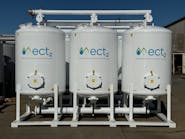Treatment and funding options for removing PFAS from drinking water
Per- and polyfluoroalkyl substances (PFAS) have been seeping into the environment and drinking water sources ever since they were mass produced for everyday products used by consumers and industry.
Pressure is increasing to adopt more stringent regulations and quickly find effective and economical remedies for PFAS-contaminated water supplies. The potential health risks surrounding PFAS have created an environment where communities are asking utilities and regulators to quickly find solutions to address, remove and destroy these contaminants.
Managers and operators at water utilities must educate themselves on PFAS, build trust with their communities, and juggle evolving regulations — all while simultaneously planning for and funding new treatment systems. As such, PFAS treatment and remediation cost are a dominant topic at U.S. water and environmental conferences, as well among regulators, utilities, academics, and environmental and public health advocates.
EPA proposes first-ever MCLs for PFAS
The Environmental Protection Agency (EPA) released the first-ever proposed national drinking water regulations for PFAS for the following six compounds: perfluorooctanoic acid (PFOA), perfluorooctane sulfonic acid (PFOS), perfluorononanoic acid (PFNA), perfluorohexane sulfonic acid (PFHxS), perfluorobutane sulfonic acid (PFBS), and hexafluoropropylene oxide dimer acid (HFPO-DA, also known as GenX Chemicals).
The maximum contaminant level (MCL) for PFOA and PFOS in drinking water are 4 parts per trillion (ppt), essentially detect levels, which may be challenging for analysis and treatment for some labs and water providers. For the remaining four compounds, PFNA, PFHxS, PFBS, and HFPO-DA, EPA is proposing that a Hazard Index approach be used, requiring contaminants to be below 1.0 on the Hazard Index.
The Hazard Index measures the extent that contaminant compares to its Health-Based Water Concentration, which is the level at which no health effects are expected. Using this approach, any combined concentration of the four compounds greater than 1.0 on the Hazard Index would exceed the MCL. The proposed rule is expected be finalized near the end of 2023 or early 2024.
Public water systems across the country will have to monitor for these six chemicals and respond if concentrations are found in excess of these levels by either taking the contaminated sources out of service or treating the contaminated sources.
PFAS treatment options
Many water agencies have already begun to address PFAS in their water supplies. PFAS treatment solutions include granular activated carbon adsorption, ion exchange resins as well as nano-filtration and low-pressure reverse osmosis membrane treatment processes.
Granular activated carbon
Granular activated carbon (GAC) has a pore structure that results in a large surface area per pound of carbon source; when used in a filter, GAC can adsorb dissolved species such as PFAS.
GAC efficacy for PFAS removal depends on the source water quality and the presence of co-contaminants like natural organic matter and other trace contaminants. GAC is also effective for treating a variety of volatile and synthetic organics including solvents, pesticides and hydrophobic long-chain perfluoroalkyl acids (PFAAs), especially perfluorinated sulfonates, such as PFOS. On the other hand, GAC is typically less effective in treating shorter-chained PFAAs such as perfluorobutanoic acid (PFBA).
Often, taller vessels, and more pairs of vessels, are required for GAC as compared to other treatment options. GAC offers low media costs per changeout, although the media life depends on the raw water quality and the treated water goals.
GAC filter media can be backwashed, so it can treat source water with higher turbidity or precipitated iron. Additionally, GAC systems can tolerate periodic doses of free chlorine to control biological activity in the feedwater supply system and GAC vessels.
Ion exchange
In an ion exchange (IX) system, contaminated water flows through a bed of media similar to a filter, and the unwanted charged contaminants in the feedwater are replaced with harmless compounds like sodium and hydrogen in cation resins, and chloride and hydroxide in anionic resins.
Ion exchange resins that treat PFAS in drinking water applications are typically highly selective, single-use resins that typically last for 6-18 months depending on the flowrate, PFAS concentration and the presence of competing anions such as sulfates and nitrates.
These highly selective long-life resins provide good removal of short and long chain PFAS. IX systems have a long resin service life, so they may foul prior to PFAS breakthrough or exhaustion. Specifically, certain IX resins deteriorate in the presence of chlorine or other oxidants.
The lack of a disinfection residual can lead to challenges in controlling biological activity in the resin bed. Although its service life can be longer, IX replacement media tends to be more expensive than GAC. To assess treatment efficacy on a given source water, testing is strongly recommended to make accurate projections.
Reverse osmosis
Membrane separation technologies such as nano-filtration and reverse osmosis (RO) can remove all PFAS tested very effectively from impacted drinking water.
In these applications, the feed water is forced through a semi-permeable membrane at high pressure (specific pressure is dependent upon the application), resulting in a high-quality finished water. Excellent removal of PFAS, including short-chained PFAS, can be attained using low-pressure RO (LPRO).
Despite LPRO’s effectiveness, it is typically the costliest method for removal of PFAS due to high capital cost and energy demand. Because LPRO may be susceptible to fouling, an anti-scalant and/or a pre-treatment step may be required to minimize potential membrane clogging. LPRO is an effective option to remove a wide variety of PFAS compounds and other possible contaminants of concern and is often the most resilient to contaminant spikes in the incoming flow stream.
Implementing treatment solutions
GAC and IX can be integrated within a utility’s existing treatment plant infrastructure. Even though many utilities use GAC or IX, potential liabilities associated with future disposal of spent media may be a concern.
For all three technologies, bench-scale and/or pilot-scale testing is critical to confirm the viability of the solution for the site-specific water matrix, and for developing system design and cost performance parameters. Bench- and/or pilot-scale testing aids in identifying the most effective treatment approach and yields insight into estimated breakthrough and anticipated changeout frequency.
The importance of the testing cannot be overstated. The information gained can be directly related to effectiveness, potential for fouling, and long-term operating cost savings. Both the capital cost and operating costs are critical considerations in evaluating the three treatment technologies, as they can vary significantly.
Each technology requires unique considerations for the items that make up the most significant proportions of life cycle costs, such as equipment cost, pumping requirements, operations and maintenance labor, and chemical needs. IX is typically more expensive than an equal volume of GAC, though IX requires smaller bed volumes for similar levels of treatment. Finding the balance between IX and GAC empty bed contact time (EBCT) and changeout frequency required to meet performance goals via pilot or bench-scale testing is critical to estimating operating costs. PFAS treatment technologies may or may not be effective for the removal of co-contaminants.
Emerging technologies
Research and development programs are developing ingenious solutions, where innovative researchers are evaluating emerging technologies to concentrate and then destroy PFAS without releasing harmful by-products.
PFAS destruction technologies have recently been demonstrated successfully at bench-scale. This includes, but is not limited to, hydrothermal alkaline treatment, photolysis, high-energy electron beam, and radiolytic. Destruction of PFAS has also been demonstrated successfully at the pilot scale using electrochemical oxidation, plasma, supercritical water oxidation, UV-hydrated electron and sonochemical.
The optimal destructive solution needs to consider the specific water quality, site constraints, disposal options and existing processes at each application.
A key component of any destructive technology is that the solution must not simply transfer the PFAS problem from one element of the environment to another (soil to air, water to wastewater, water to landfills, etc.). Therefore, the push to identify, develop, and implement effective and affordable destructive technologies that eliminate PFAS from the environment altogether is essential to overall public health.
Who should pay for the cost of cleanup?
Water agencies have played no role in producing PFAS, yet they are the ones who are facing the burden of removing these contaminants from their water supply. As water providers across the nation discover these contaminants in relative unison, the demand (and cost) for treatment technologies and infrastructure upgrades are likely to rise.
The bipartisan Drinking Water and Wastewater Infrastructure Act of 2021 includes a comprehensive package that will invest billions of dollars in drinking water and wastewater infrastructure to address PFAS and other unregulated contaminants. However, the funds come with restrictions on what it can be used for and excludes the long-term costs of running these facilities.
Unless the manufacturers responsible for this pollution are held accountable, the billions of dollars to clean the contaminated water will a burden borne by rate payers, who have also likely been exposed to the toxic chemicals.
Over the past two decades, litigation has helped expose not only the dangers of these chemicals but how much the manufacturers knew and withheld information about those dangers. In past cases pursued against PFAS manufacturers, an enormous amount of evidence was produced demonstrating wrongdoing on the part of those manufacturers, making litigation a good option for water providers to consider.
Multidistrict litigation moves ahead in federal court
Already, over 2,000 plaintiffs have joined a multidistrict litigation (MDL) for aqueous film-forming foams (AFFF) used in fire extinguishing. AFFF contains two of the most common forms of PFAS: PFOA and PFOS.
MDLs are used to coordinate complex litigation filed in multiple federal district courts involving common questions of fact. By consolidating the discovery and pretrial motions, both sides save time and money. The benefit for plaintiffs is that attorneys can pool their resources and coordinate efforts. If the initial cases (often called “bellwether” cases) are resolved in favor of the plaintiffs, it often results in a domino effect of settlements for the remaining cases.
While there are several categories of plaintiffs in the MDL, the court has selected the water provider cases as the source of the first bellwether trial. The bellwether trial, City of Stuart v. The 3M Company, et al., is expected to be heard in the Federal District Court of South Carolina in June 2023.
With proceedings already well underway for water providers in the MDL and the bellwether trial set to start in just a few months, now is a good time for water providers considering litigation to join. The process to join is relatively straightforward and some law firms, like SL Environmental Law Group, will work on a contingency fee basis. This means the fee is set at the beginning and is only due when the case achieves a favorable result — this includes costs like court filing fees, deposition transcription fees, and hiring and experts witness fees.
Statute of limitations
Lawsuits are subject to statutes of limitations — a time limit that applies to every legal claim. Outside of special circumstances, claims cannot be brought after the statute of limitations has run out, no matter how valid — or valuable — they are. While the calculation of a statute of limitations varies from jurisdiction to jurisdiction, for many water providers they generally begin once the discovery of the contaminants has been identified in the water supply or when the provider takes some action in response to the awareness of the contaminant.
Water providers can file a claim to get ahead of the statute of limitations, even if they detect these chemicals below the MCL. This gives a time period of protection if things change and investment in new treatment facilities is required.
Rapid change on all fronts
In December 2022, 3M announced it will stop making PFAS by 2025 — an indication that past actions have finally caught up to the company. But this announcement does not fix our current PFAS problem.
These chemicals are pervasive, have been discharged into the environment since the 1950s, and do not break down naturally. It will still make its way to our groundwater sources for years to come. Given the extensive scientific findings on the dangers of PFAS, it is likely that increased regulation on PFAS is to be expected from both federal and state authorities.
Each water agency will have to determine the right treatment based on the type of PFAS contamination they have, and they will need to find a way to pay for the removal of these contaminants.




